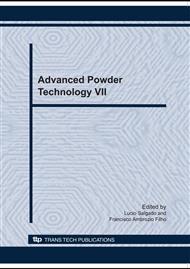p.971
p.977
p.983
p.989
p.995
p.1003
p.1009
p.1015
p.1019
Effects of Dependence between Solid Solution and Surface Excess in Nanoparticles
Abstract:
In this work, samples of 10 mol% Mg-doped SnO2 were synthesized by Pechini's method and calcined at 500°C. Previous analysis suggests that the additive is preferentially located on the surface of nanoparticles as a surface excess. Since MgO is highly soluble even in weak acid medium, the samples were "washed" with concentrated nitric acid for a few hours in order to remove Mg from the surface. After the lixiviation, the sample was thermally treated again. This procedure was carried out five times using the same sample, and the dependence between macroscopic properties and surface excess was demonstrated, since it was detected a direct relationship on particle size and isoelectric point on each new washing. Also, a new method to measure surface excess in solids was applied.
Info:
Periodical:
Pages:
995-1000
Citation:
Online since:
October 2010
Authors:
Keywords:
Price:
Сopyright:
© 2010 Trans Tech Publications Ltd. All Rights Reserved
Share:
Citation:


